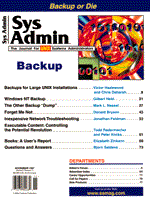
Editor's Forum
Backup has long been the bane of system administrators. Everyone knows that the process of performing backups and managing the resulting tape stores is an essential element of system administration. Users seldom appreciate the time you spend attending to this process, and appreciate even less any disruption to their host access. Until, that is, they need a critical file restored. (The most imaginative excuses for accidentally erased files might make an interesting contest.) While little has changed about the importance of backups, the technology available to perform the task has evolved significantly. And, as usual, there is both good and bad news associated with this evolution. The good news is that several excellent high-capacity tape technologies are currently available to do backups. The venerable QIC tape format, the most common backup choice for small to mid-sized UNIX systems, has finally advanced to a competitive position again. Tandberg Data's new MLR1 QIC drives have a native capacity of 13 GB per tape, and maintain full backward read and write compatibility with earlier QIC formats. Similarly, 4-mm DAT drive technology has recently been upgraded by the introduction of the DDS-3 format, with a native capacity of 12 GB, from vendors such as Hewlett Packard, Seagate, and Sony. More importantly, DDS3 drives are sufficiently robust that some library vendors are now starting to ship systems built around DDS3 drives. Although late to market, Exabyte has also advanced their 8-mm product line with the new Mammoth drives (native capacity 20 GB). Quantum's Digital Linear Tape (DLT) technology, purchased as part of a deal with Digital Equipment Corp, is now at the DLT7000 development stage with a capacity of 35 GB, and has become the tape technology of choice during the past several years with library vendors. DLT, however, has new competition from Sony's Advanced Intelligent Tape (AIT) technology, which with a more efficient compression method (ALDC), rivals the DLT7000's compressed capacity. Watch for 8-mm AIT libraries from vendors such as Spectra Logic to start taking market share away from DLT-based products. The bad news, however, is that all of these tape technologies are advancing at a rate that typically doubles the capacity from one generation to another. While impressive, a mere doubling of capacity may not be sufficient to keep up with disk drive technology that is on the horizon. In the not-too-distant future, your backups may once again be playing catchup with your total system drive capacity. I am referring, of course, to disk drives based on near-field recording techniques. That disk drive technology promises to increase hard disk capacity by an order of magnitude, and can apparently do so on very inexpensive substrata - making such disks cheap to produce. Although hard disk vendors that I have talked to are staying mum about near-field disks at present, I suspect that we will start seeing products in the next year or so. The impact of hard disks based on near-field recording on your backup strategies is, of course, yet to be seen. While all of the tape technologies mentioned earlier have advantages for various requirement mixes, consider the impact that a couple of disk arrays made up of 90-GB, 3.5-inch drives will have on your backup window. You may want to balance between current requirements and tape technologies that have plenty of head room for future advancement.
Sincerely yours,
|